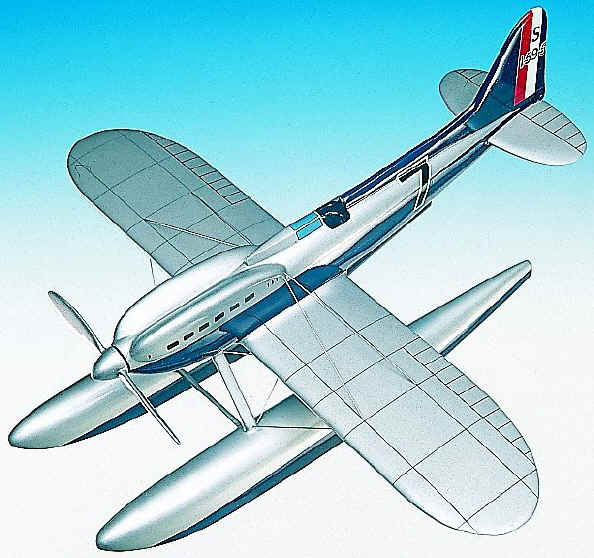|
|
 |
Supermarine
S-6B Floatplane |
|
|
|
More than a million spectators were cheering as RAF Flight
officer H.R.D. Waghorn set down his Supermarine S-6 in southern
England's Solent Channel on September 10, 1929. Waghorn
had just flown an average of 328 mph around the triangular
course to defeat his Italian rivals and capture Britain's second
straight Schneider Trophy win.
France,
Italy and the U.S. had all won the Schneider trophy in the past,
as had Britain. But none of the four had managed to win three
out of five consecutive races, as required for retiring the
trophy. Now Britain stood within reach of the elusive goal and,
shortly after Waghorn's victory, Prime Minister McDonald vowed
that England would do her level best to win the next race in
1931. But a
few months later, McDonald's Air Ministry stunned the Aero Club
of Britain -- sponsors of the country's Schneider Trophy entries
-- by announcing the government would give no financial support
to future Schneider trophy efforts. Without this financial
support, the Aero Club could not develop a new racer to compete
with heavily subsidized French and Italian challengers expected
in 1931.
The British public was outraged. Their
country's prestige was at stake. Soon several million
pounds were raised to support the home team. Disaster struck the Italian and French teams. Mid-summer crashes
claimed a top plane and top pilot from each. Crippled by these
losses, both countries withdrew from the race a week before it
was scheduled to be run. On
Sunday, September 13, 1931, RAF Lieutenant John Boothman flew
the S-6B, unopposed, over the Solent Channel course at an
average speed of 340 mph. With courage, skill and a little bit
of luck, England had retired the Schneider Trophy.
Was it
worth all the money, work and heartache to claim a
fairly ugly, now almost forgotten trophy? The British think it
was. Because five years after the 1931 race, Reginald J.
Mitchell introduced a new Rolls Royce powered interceptor
fighter incorporating many lessons he had learned designing
Schneider Trophy seaplanes. Someone gave Mitchell's fighter a
nickname, which stuck: "Spitfire."
|
|

|
Supermarine
S-6B Floatplane
Deluxe Series. 1/20th scale. 18" wingspan x
17.5" long.
No. ABRAD-DX. Only $179.95 |
|
